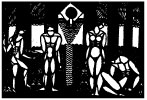|
|
| |
The Princess Marries the Page
by Edna St. Vincent Millay
|
| |
The opening night of the 1918-1919 season in the new Provincetown Playhouse at 133 Macdougal Street began with the one-act The Princess Marries the Page by Edna St. Vincent Millay. This play had been premiered on May 12, 1917 at Vassar College, where Millay had been a student, and she played the Princess in the performance. It was also performed at The Bennett School in Millbrook, NY, where Millay had briefly taught, opening on October 22, 1917, before its New York City premiere at the Provincetown. For the Provincetown production, Millay again played The Princess, with Vadim Ureneff as The Page, Hutchinson Collins as The King, O.K. Liveright as The Lord High Chancellor, and Robert Edwards, Louis B. Ell, and Frederick Ward Roege as First, Second, and Third Soldiers. Millay directed the play and C.M. Cox designed the set, of which Heywood Broun in the New York Tribune said, “Visually, The Princess Marries the Page is the finest thing on the bill, for C.M. Cox has provided a gorgeous setting.”
The Princess Marries the Page was Millay’s first attempt at playwriting while she was an undergraduate at Vassar and, like her Two Slatterns and the King for the Others’ bill, it was written as an assignment for a playwriting class. Structured in verse and filled with fairy-tale language, it portrays a Princess in her tower whose reading is interrupted by a Page playing a song on his silver pipe. When he refuses to stop playing on her command, she becomes intrigued and is quickly attracted to him. While beginning to fall in love with her as well, the Page confesses that he is really the son of their enemy monarch and had come to ruin her father. When her father, the King, comes to her, questioning if she has seen the spy posing as a page, she lies and says no, but the Page jumps out of hiding so as to not let her perjure herself. He reveals his true identity, but also reveals he has purposefully failed in his spying mission by one day. The King informs him his father has died the day before. Because of his honesty, The King acknowledges the desire of the “Page” to be with his daughter.
An anonymous reviewer from the Dramatic Mirror simply said the play “has a very sophomoric story told in blank verse that sometimes has fluency and grace, but shows too evident a striving for beauty and poetry.”(2) Broun offered that “Blanche Hays has also contributed some beautiful costumes. The verse and drama seemed to us to be of much thinner stuff.”(3) In the introduction to the published version of the play in 1932, Millay writes that it is “unmistakably a youthful work, and very slight, but I thought it rather pretty.”(4) Given the unusual style and lack of theme typical of other Provincetown-produced plays, it is likely Cook promised Millay a production back in September both to assure that the poet and her sisters would continue in their commitment to the company, and for any residual publicity that the budding poet’s name might lend to the Playhouse.(5)
© Jeff Kennedy, 2007.
(1) Heywood Broun, New York Tribune, 25 November 1918, col. 4: 9.
(2) Sarlos notes, from UC Davis.
(3) New York Tribune, 25 November 1918, col. 4: 9.
(4) Edna St. Vincent Millay, The Princess Marries the Page (New York: Harper and Brothers Publishers, 1932) xii. There was one substantial revival of the play in 1930 with quite a distinguished cast. Deems Taylor and Mary Kennedy, friends of Millay, and her husband Eugen Boissevain asked Millay during a visit in 1930 if she had a play for an annual presentation they made at the Cosmopolitan Club in Philadelphia. Taylor later wrote music for the Page’s pipe-playing scenes, direction was by the noted actor Dudley Digges, sets by Grant La Farge, and costumes were provided by the Metropolitan Opera Company. Mary Kennedy played the Princess, and two of the minor parts, the First and Third Soldiers, were played by a “couple of promising young composer-friends of the Taylors: Samuel Barber and Gian-Carol Menotti” Jean Gould, The poet and her book; a biography of Edna St. Vincent Millay (New York: Dodd, Mead, 1969) 212.
(5) George Cram Cook, letter to Susan Glaspell, qtd. in Sheaffer, Playwright 437-438.
|
| |
|
|
|
